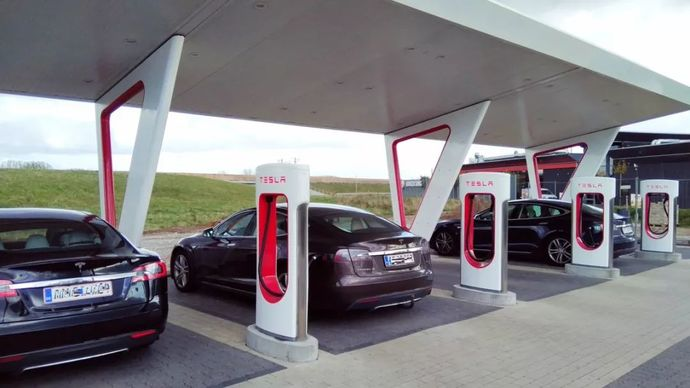Last Sunday, Captain Zherun discovered a supercharging pile under maintenance at Shanghai Jinqiao Tesla supercharging station that is very similar to the V3 supercharging pile in the US. Unless there are any accidents, Jinqiao will become the first V3 supercharging station in China before 2020, and the second country in the world to introduce V3 supercharging after the US.

Firstly, let’s briefly talk about Tesla’s V3 supercharging. In March this year, Tesla released the third-generation supercharging system, which directly increased the peak power from the original 120 kW of the V2 supercharging to 250 kW.
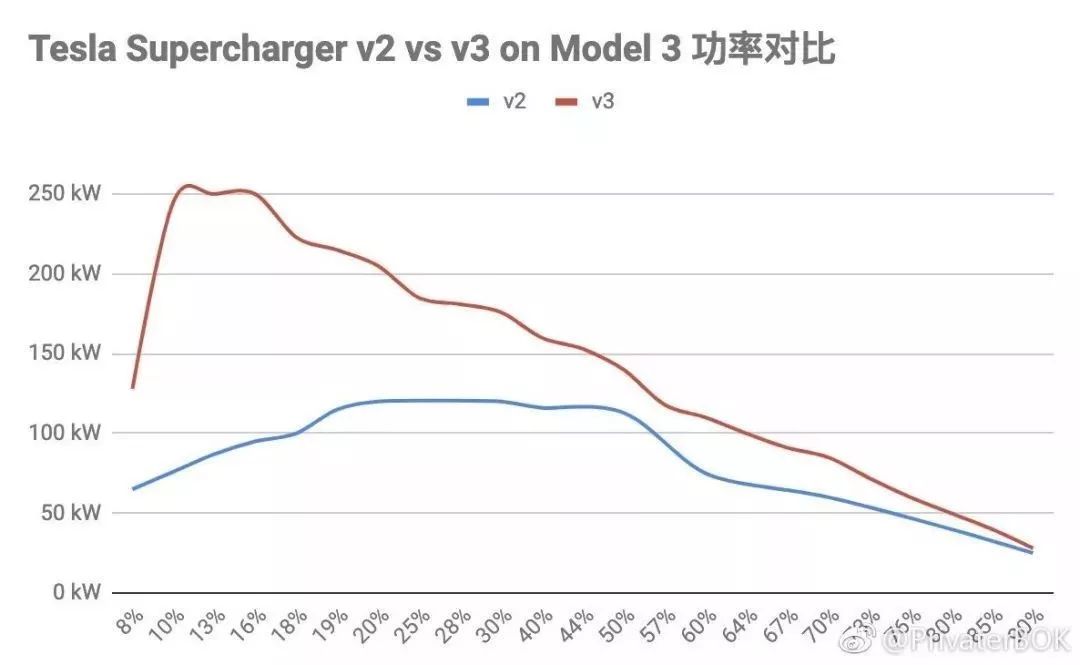
After testing by American car owner @PrivaterBOK, it only took 25 minutes for Model 3 long-range version to charge from 9% to 80% on the V3 supercharging pile, and even when charged to 90%, it only took 35 minutes.
Although V3 supercharging piles can significantly improve the charging efficiency of Tesla vehicles, “how to significantly increase the number of supercharging piles for the Chinese market next year is even more important”.
1.28:1 extremely low ratio of parking spots to charging piles
In September 2012, the first eight supercharging stations began trial operation along the highways from Boston to Washington and from San Francisco to Los Angeles. So far, Tesla has opened 1711 supercharging stations worldwide, with a total of over 15000 supercharging piles, an average of about 8.8 supercharging piles per supercharging station.
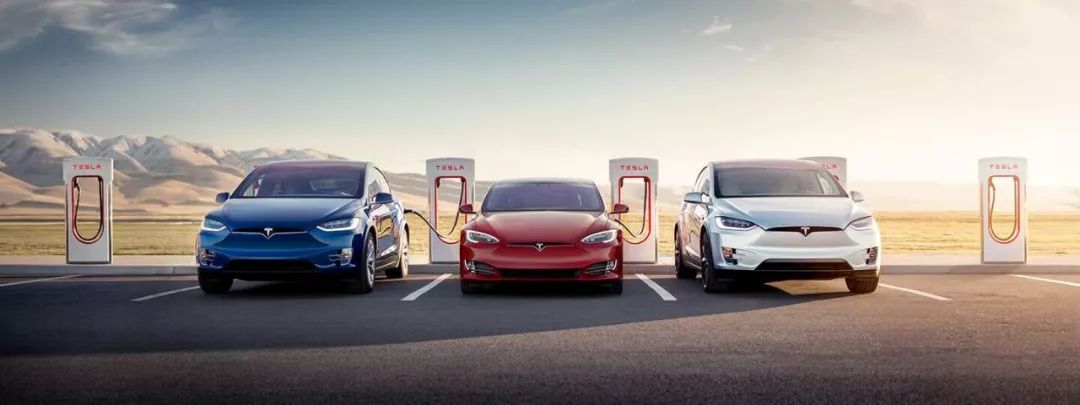
Among them, the number of supercharging stations opened in the US is far ahead, with a total of 738, about 6500 supercharging piles. In contrast, there are only 276 supercharging stations in China and about 2400 supercharging piles.
At first glance, Chinese Tesla owners seem a little miserable. However, as of Q3 2019, Tesla has sold about 500,000 cars in the US and about 78,000 cars in China. Moreover, it is understood that the proportion of home charging in China and the US is about 75% respectively, meaning that there are about 375,000 Tesla owners with home charging in the US and about 58,500 in China.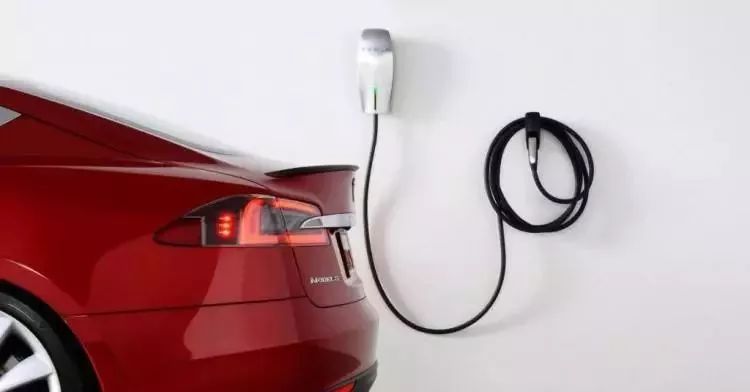
Due to the fact that most of Tesla owners in the US only charge their cars at Tesla Superchargers, the car-to-charger ratio (including both Superchargers and home chargers) is approximately 1.31:1 in the US and 1.28:1 in China, with the two countries being almost equal in terms of car-to-charger ratio.
What does 1.28:1 mean? According to the website of the Ministry of Public Security, the total number of new energy vehicles in China reached 3.44 million by the end of June 2019. According to the information released by the Electric Vehicle Charging Infrastructure Promotion Alliance in November 2019 regarding the construction and operation of charging infrastructure in China, the total number of charging stations nationwide (including public charging stations and home chargers) in November 2019 was 1.174 million.
Based on these figures, the overall car-to-charger ratio in China is about 2.93:1, more than double Tesla’s ratio. Therefore, although the absolute number of Tesla Superchargers is not high, there are rarely any queues for charging.
Tesla Supercharger Network Expansion Accelerates
The domestic Model 3 is about to be delivered. At the same time, according to Bloomberg News today, insiders said that Tesla is considering lowering the price of Model 3 in the second half of next year, which may reach 20% or more due to the slowdown of the market, which will attract more buyers.
Although Tesla China responded that “we have not heard of this matter, please pay attention to official website information,” the first phase of the Shanghai factory has a capacity of 150,000 vehicles per year. Although it takes some time to ramp up the production capacity, it can be expected that Tesla’s production in China will likely exceed 100,000 units next year. Tesla’s production capacity has always been roughly equal to its sales volume, so price reduction is just a matter of time.
It is believed that as the price of domestic Model 3 continues to fall, the proportion of car owners with home-charging conditions will significantly decrease, and it can be seen that Tesla’s Supercharger network will face huge challenges.
However, Tesla China has already made preparations. In July of this year, Tesla China held a media briefing in Shanghai. Xue Juncheng, the general manager of Tesla China’s service department, mentioned that the slogan of Tesla’s Supercharger construction team is “make charging easy for everyone,” and the team’s goal is to eliminate charging anxiety for users without private chargers through the efforts of engineering and technical teams.
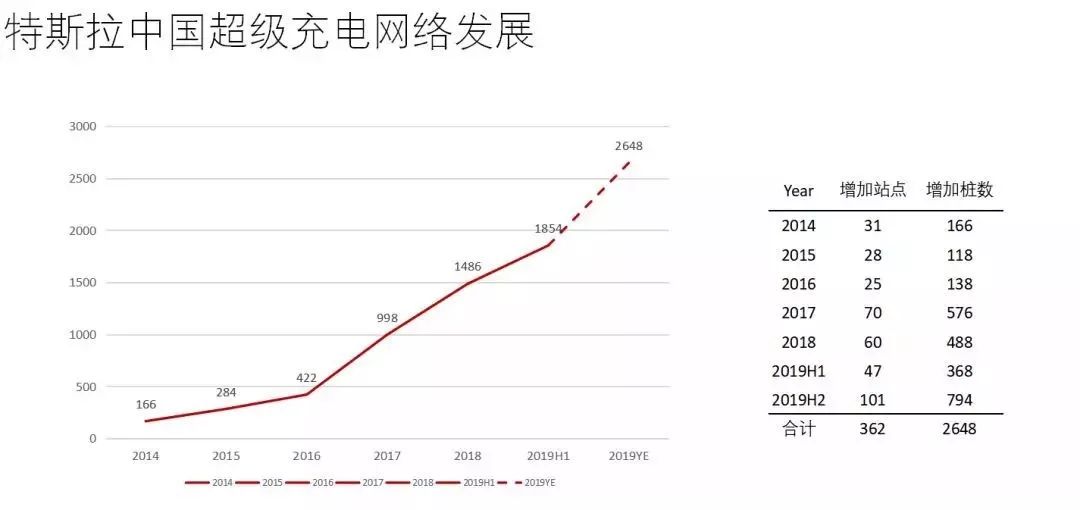 In 2019, Tesla plans to build 148 new Supercharger stations in China, bringing the total to 362 Supercharger stations. The layout logic will be based on increasing the network density in existing cities and expanding into new cities, which means turning non-existent locations into existent locations, existing locations into multiple locations, and multiple locations into even more locations.
In 2019, Tesla plans to build 148 new Supercharger stations in China, bringing the total to 362 Supercharger stations. The layout logic will be based on increasing the network density in existing cities and expanding into new cities, which means turning non-existent locations into existent locations, existing locations into multiple locations, and multiple locations into even more locations.

As the year draws to a close, it’s clear that Tesla won’t be able to meet the ambitious target set earlier this year, given that there are only 276 Supercharger stations currently open in China. However, the Supercharger Map on Tesla’s official website is densely packed with planned stations in China, so we hope Tesla won’t let us down next year.
More charging posts + higher efficiency = better driving experience
One reason why Tesla’s charging infrastructure is hardly ever criticized is that it has a relatively low ratio of cars to charging posts, and, more importantly, it maintains peak efficiency throughout the entire charging process.
- Fast
Third-party fast charging posts are typically DC charging posts with a capacity of 60 kW. However, since the maximum output current for such charging posts is only 120 A, the maximum charging power for most models is only about 47 kW. In contrast, most of the Supercharger stations currently open in China are the second-generation, 120 kW posts. Models 3/S/X Long Range can easily reach 120 kW, and even the Model 3 Standard Range Upgrade version can achieve a maximum charging power of 100 kW.
- More than just fast
Obviously, charging speed is important, but Tesla has gone far beyond that by making every step in the charging process as efficient as possible.

Firstly, the Tesla vehicle system comes with a Supercharger Map that displays occupancy status of charging posts in real time. Tesla also has a dedicated maintenance team behind Supercharger stations who can respond quickly to any reported problems or failures, effectively avoiding situations where queueing or failing posts could hamper the charging process.
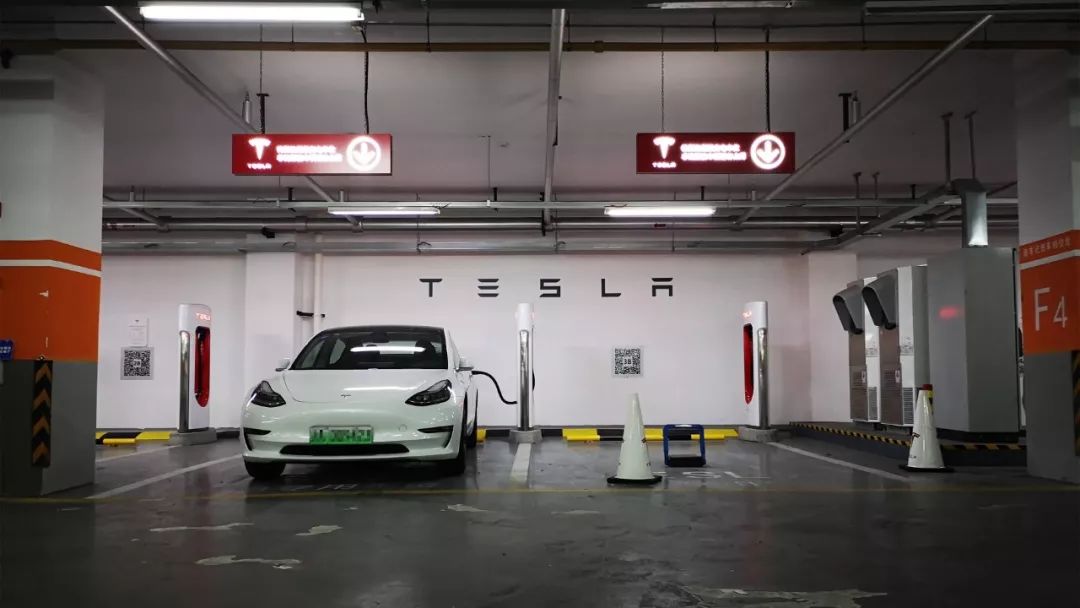
Secondly, to prevent other makes of vehicles from occupying the charging posts, some Supercharger stations have installed ground locks or personnel surveillance. In addition, Tesla also charges an overstay fee for Supercharger stations, which means that customers must leave the charging spot within five minutes of reaching their target charging level, significantly increasing the utilization rate of Supercharger posts.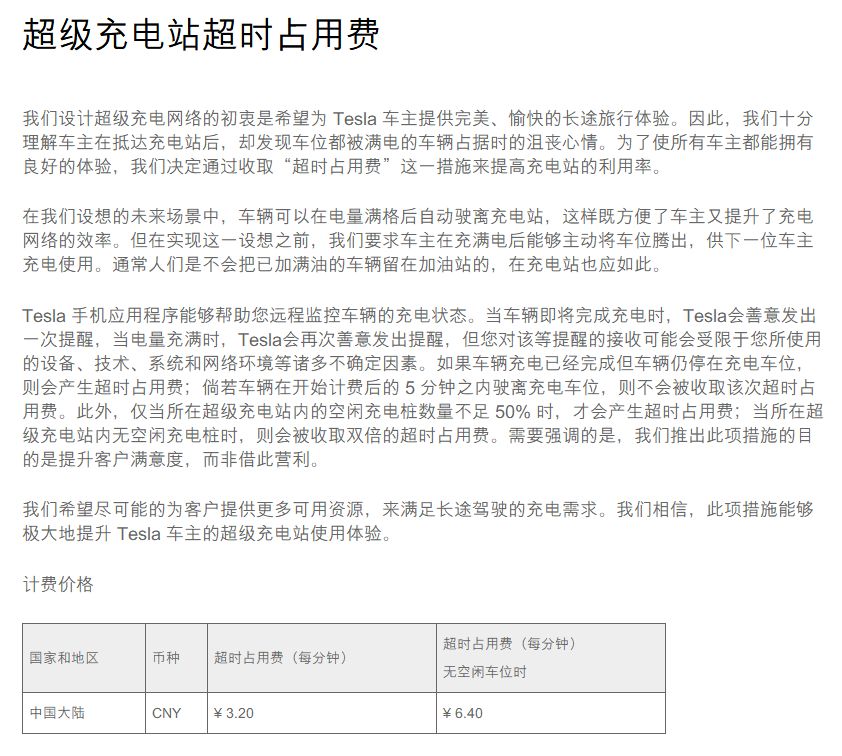
Tesla has greatly simplified the process of charging, unlike most third-party charging piles which require complicated QR code payment before and after charging. The simple process is “plug in to start charging, unplug to leave”, and the payment is settled automatically through the smartphone app’s linked credit card, making it a seamless experience.
Regarding supercharging settlement, there is one noteworthy point: Tesla China currently does not require binding a credit card, and even without binding a credit card, supercharging is still available.
This means that without binding a credit card for charging, the system cannot charge any fees, and even visiting the after-sales service center will not provide any payment channel. Therefore, if you have not yet bound your credit card, it is better not to do so, after all, Tesla’s benefits are not easily obtained.
NIO and XPeng team up to break the impasse
When many car companies were still brainstorming for ways to improve the range of their electric vehicles, Tesla had already been in the charging service industry for 7 years. Building a charging station itself is a heavy asset, slow return project, and in these 7 years, Tesla has been on the verge of bankruptcy several times, but the construction of supercharging stations has never stopped.

Back in 2015, Zhu Xiaotong, Tesla’s Vice President and Head of Greater China, said, “There is a paradox in the promotion of new energy vehicles: which comes first, the chicken or the egg. A major bottleneck for new energy vehicles is the construction of charging infrastructure, and solving the anxiety about range is a challenging task for the entire industry.”
As Tesla’s disciples in China, NIO and XPeng are also keenly aware of this problem and have established their own supercharging systems. Since the first 30 supercharging stations were put into operation in March 2019, XPeng Motors has built and operated a total of 76 supercharging stations in 18 cities as of September 2019. NIO, on the other hand, has set up 15 supercharging stations in 13 cities since opening its first supercharging station in Suzhou in July this year.
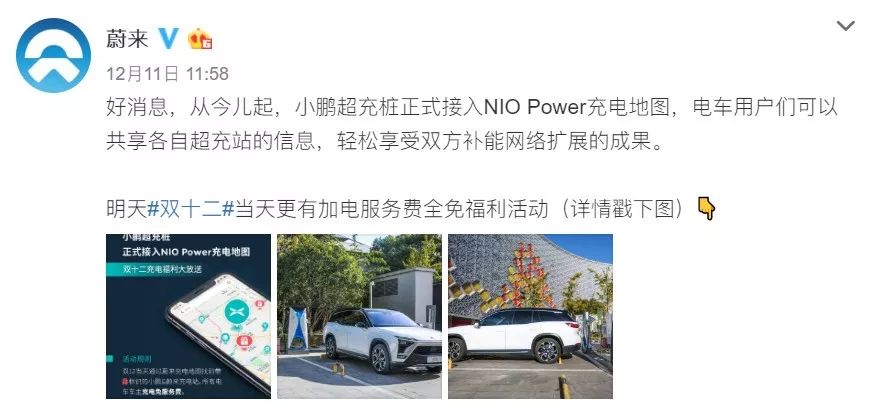 Although the number of charging stations for both is still far from enough for most electric vehicle owners, on December 11th, NIO and XPeng announced their cooperation in the charging business, which will realize the interoperability of charging station location data and payment processes nationwide. Both parties’ owners can use each other’s super charging stations.
Although the number of charging stations for both is still far from enough for most electric vehicle owners, on December 11th, NIO and XPeng announced their cooperation in the charging business, which will realize the interoperability of charging station location data and payment processes nationwide. Both parties’ owners can use each other’s super charging stations.
This cooperation to some extent eased the problem of owners’ difficulty in finding and charging stations in daily use, optimized the experience of using electric vehicles, and also demonstrated and promoted China’s electric vehicle industry. We look forward to more companies deepening cooperation and sharing in charging services in the future.
As NIO’s Vice President Shen Fei also said on Weibo, “This is just the beginning. NIO Power is working with all like-minded partners with an attitude of openness, sharing, and win-win, committed to improving the safety and convenience of electric vehicles, and allowing more people to understand, like and make good use of electric vehicles”.
This article is a translation by ChatGPT of a Chinese report from 42HOW. If you have any questions about it, please email bd@42how.com.
